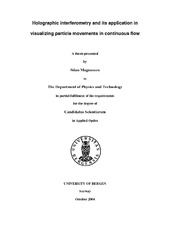Holographic interferometry and its application in visualizing particle movements in continuous flow
Master thesis
Permanent lenke
https://hdl.handle.net/1956/1343Utgivelsesdato
2004Metadata
Vis full innførselSamlinger
Sammendrag
This thesis presents the work performed at the Department of Physics and Technology at the University of Bergen during a collaborative project funded by Statoil. The parties in this collaboration were the University of Bergen, Rogaland Research (RF) and the University College of Stavanger The overall project objective was to visualize and quantify particle motion in continuous flow. At the Department of Physics and Technology we have built a closed-loop tank system consisting of three glass tanks. These tanks were positioned at different heights to provide the required pressure. The fluid streamed from an upper reservoir through an inspection tank and to a lower reservoir. The tanks were interconnected by Teflon coated pipes to enable the use of a fluid consisting of two chemical solvents. The fluid was designed to match the refractive index of a selection of 2 mm glass particles at a specific wavelength to improve our investigation possibilities. This index matching enabled marked particles to be identified inside an almost invisible moving mass. Holography is proposed as a new way of investigating the lower, slow moving, particle layers in sand dune transportation. Our thesis constitutes the theoretical background for holography and its more advanced interferometric techniques. We compare available double exposure theories with experimental holography for objects with various static movements. We later advance to a more dynamic optical system. The study of a holographic recording medium called Bacteriorhodopsin is presented. A continuous observation of a changing object has never been tested at our Optics Group at the Department of Physics and Technology before. We introduce real time holography using a Bacteriorhodopsin film and perform holography with continuous flow in the tank system. Faced with mechanical instabilities in the tank system, we found that the optical technique was too sensitive to these, and therefore not the most suitable method for examining particles in continuous flow in the built tank system. However, in general the real time holographic technique documented in this thesis is very promising and can readily be applied in numerous scientific areas.
Utgiver
The University of BergenOpphavsrett
The authorCopyright the author. All rights reserved
